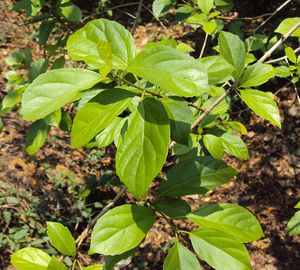Note: This is a project under development. The articles on this wiki are just being initiated and broadly incomplete. You can Help creating new pages.
Difference between revisions of "Premna serratifolia - Ganakasika"
m (Jayashree moved page Premna serratifolia to Ganakasika) |
|||
| Line 1: | Line 1: | ||
[[File:665px-Premna serratifolia 05.JPG|thumb|right|''Ganakasika'', ''Premna serratifolia'']] | [[File:665px-Premna serratifolia 05.JPG|thumb|right|''Ganakasika'', ''Premna serratifolia'']] | ||
| + | '''Ganakasika''' or '''Premna serratifolia''' is a small tree/shrub in the Verbenaceae family. It flowers and fruits between May and November. During flowering season, it attracts a large number of butterflies and bees. | ||
| − | + | == Description == | |
| + | |||
| + | Trees, to 7 m high. Leaves simple, opposite, estipulate; petiole 4–14 mm, slender, pubescent, grooved above; lamina 2.5-8.5 x 2-7.2 cm, elliptic, elliptic-oblong, base acute, obtuse, subcordate or rounded, apex acuminate, mucronate, obtuse, margin entire or subserrate, glabrous above except along the appressed midrib, chartaceous; lateral nerves 3-5 pair, pinnate, prominent, puberulous beneath; intercostae reticulate, obscure. Flowers bisexual, greenish-white, in terminal corymbose panicled cymes; bracts small; calyx small campanulate, 2 lipped, 5 lobed; corolla tube short, villous inside, lobes 5; stamens 4, didynamous, inserted below the throat of the corolla tube; anther ovate; ovary superior, 2-4-celled, ovules 4; style linear; stigma shortly bifid. Fruit a drupe, seated on the calyx, globose, purple; seeds oblong. | ||
| − | + | == Uses == | |
| − | #The leaves and roots are used in traditional medicine as a diuretic, stomachic and febrifuge. | + | #The leaves and roots are used in traditional medicine as a diuretic, stomachic and febrifuge.<ref name="uses"/> |
#The root has a warm bitter taste and agreeable smell, it is prescribed in decoction as a gentle cordial and stomachic in fevers. | #The root has a warm bitter taste and agreeable smell, it is prescribed in decoction as a gentle cordial and stomachic in fevers. | ||
#The leaves are used as a galactagogue, and also to treat rheumatic arthritis; colic and flatulence; coughs, headaches and fevers. The leaves,combined with those of morinda citrifolia, are squeezed into water and the solution drunk twice a day to treat severe malarial fevers.A steam bath made from the leaves and young stems is breathed in as a treatment for fevers. The cooled solution is then used to bathe the body. | #The leaves are used as a galactagogue, and also to treat rheumatic arthritis; colic and flatulence; coughs, headaches and fevers. The leaves,combined with those of morinda citrifolia, are squeezed into water and the solution drunk twice a day to treat severe malarial fevers.A steam bath made from the leaves and young stems is breathed in as a treatment for fevers. The cooled solution is then used to bathe the body. | ||
#The leaves are boiled into medicinal tea that is reputed to have analgesic effects. This home remedy is used mostly in the treatment of backaches. | #The leaves are boiled into medicinal tea that is reputed to have analgesic effects. This home remedy is used mostly in the treatment of backaches. | ||
#A tea made from the boiled bark is used to treat neuralgia. | #A tea made from the boiled bark is used to treat neuralgia. | ||
| + | |||
| + | == References == | ||
| + | |||
| + | <references> | ||
| + | <ref name="uses">[http://tropical.theferns.info/viewtropical.php?id=Premna+serratifolia "Premna serratifolia-Useful Tropical Plants"]</ref> | ||
| + | </references> | ||
| + | |||
| + | == External Links == | ||
| + | |||
| + | *[https://en.wikipedia.org/wiki/Premna_serratifolia Premna serratifolia-Wikipedia] | ||
[[Category:Herbs]] | [[Category:Herbs]] | ||
Revision as of 10:08, 2 January 2017
Ganakasika or Premna serratifolia is a small tree/shrub in the Verbenaceae family. It flowers and fruits between May and November. During flowering season, it attracts a large number of butterflies and bees.
Contents
Description
Trees, to 7 m high. Leaves simple, opposite, estipulate; petiole 4–14 mm, slender, pubescent, grooved above; lamina 2.5-8.5 x 2-7.2 cm, elliptic, elliptic-oblong, base acute, obtuse, subcordate or rounded, apex acuminate, mucronate, obtuse, margin entire or subserrate, glabrous above except along the appressed midrib, chartaceous; lateral nerves 3-5 pair, pinnate, prominent, puberulous beneath; intercostae reticulate, obscure. Flowers bisexual, greenish-white, in terminal corymbose panicled cymes; bracts small; calyx small campanulate, 2 lipped, 5 lobed; corolla tube short, villous inside, lobes 5; stamens 4, didynamous, inserted below the throat of the corolla tube; anther ovate; ovary superior, 2-4-celled, ovules 4; style linear; stigma shortly bifid. Fruit a drupe, seated on the calyx, globose, purple; seeds oblong.
Uses
- The leaves and roots are used in traditional medicine as a diuretic, stomachic and febrifuge.[1]
- The root has a warm bitter taste and agreeable smell, it is prescribed in decoction as a gentle cordial and stomachic in fevers.
- The leaves are used as a galactagogue, and also to treat rheumatic arthritis; colic and flatulence; coughs, headaches and fevers. The leaves,combined with those of morinda citrifolia, are squeezed into water and the solution drunk twice a day to treat severe malarial fevers.A steam bath made from the leaves and young stems is breathed in as a treatment for fevers. The cooled solution is then used to bathe the body.
- The leaves are boiled into medicinal tea that is reputed to have analgesic effects. This home remedy is used mostly in the treatment of backaches.
- A tea made from the boiled bark is used to treat neuralgia.
